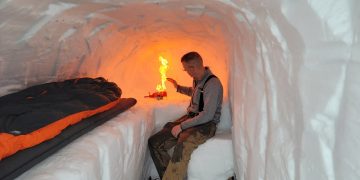Surviving in extreme cold conditions is a challenge that requires a deep understanding of the environment, the materials available, and the art of constructing a shelter that not only protects from the elements but also ensures warmth. Whether you’re lost in a remote wilderness, facing an emergency survival situation, or preparing for a winter camping trip, knowing how to build a shelter that will keep you warm can mean the difference between life and death.
In this guide, we will explore the essential principles and techniques for building a shelter that offers insulation and protection from extreme cold. From choosing the right location to using innovative techniques to retain heat, you will gain a comprehensive understanding of how to keep your body safe and warm in the most inhospitable environments.
Understanding Cold Environments: The Basics
Before diving into the specifics of shelter building, it is essential to understand the characteristics of extreme cold environments. Cold temperatures alone don’t pose the greatest risk; it’s the combination of cold, wind, and moisture that creates life-threatening conditions.
In cold climates, the body loses heat rapidly, especially when exposed to wind and moisture. The wind chill effect, where wind increases the rate at which your body loses heat, can cause frostbite and hypothermia in a matter of minutes. This makes it crucial not just to insulate your shelter from the cold but also to shield it from the wind and moisture.
The Shelter Basics: What You Need to Know
A shelter serves two primary purposes in cold weather: protecting you from the elements and keeping the heat you generate trapped inside. When temperatures dip below freezing, every choice you make about your shelter—from materials to structure—will impact your ability to stay warm.
1. Location is Key
Selecting the right location for your shelter is one of the first and most important decisions you’ll make. A good location can drastically improve the warmth and safety of your shelter, while a poor choice could expose you to more risk. Keep the following points in mind:

- Avoid low-lying areas: Cold air sinks, and valleys or depressions often accumulate cold, damp air, making them undesirable spots for shelter. Instead, aim for a raised, sheltered area where air circulation isn’t as stagnant.
- Protection from wind: Position your shelter so that it’s shielded from the prevailing wind. A natural windbreak, such as a cluster of trees or a rock formation, can provide essential protection.
- Consider snow coverage: If you’re in a snowy environment, seek a place with adequate snow accumulation. Snow acts as an insulator, so areas with thick snow cover can help keep your shelter warmer.
- Proximity to resources: Make sure your shelter is not far from a source of firewood, water, and other resources. However, avoid setting up near natural hazards like avalanche zones or unstable cliffs.
2. Choosing the Right Materials
When constructing a shelter, the materials you choose are crucial in determining its insulation and durability. Here are some of the most effective materials for keeping warm in extreme cold:
- Snow and ice: Believe it or not, snow and ice can actually be used as building materials for shelters. Snow has excellent insulating properties, trapping air in its crystals to reduce heat loss. Ice, while not as efficient as snow, can also be used for structural elements, like walls or floors, in some emergency shelters.
- Logs and branches: In forested environments, logs and branches can form the structure of your shelter. These materials, especially when layered properly, provide solid insulation against the cold.
- Animal hides or tarp: In some situations, materials like animal hides or tarps can serve as an outer layer for your shelter, offering waterproofing and wind protection. Make sure they are thick enough to prevent heat loss.
- Boughs and pine needles: In a forest, pine needles, evergreen boughs, and other foliage are valuable for creating bedding that keeps you insulated from the ground. They are also great for layering within the walls of a shelter to add warmth.
3. Insulation is Everything
No matter what materials you use, insulation is essential to creating a warm shelter. Insulation works by trapping air, which slows down the transfer of heat. In extreme cold conditions, having multiple layers of insulation will keep you warmer for longer.
- Floor insulation: The cold ground can quickly drain heat from your body. Lay down a thick layer of insulating material such as leaves, pine boughs, or even your own gear to insulate your shelter floor.
- Wall insulation: The walls of your shelter should be made thick, with as many layers as possible. Consider using snow or branches as primary materials, and fill in gaps with smaller debris or even clothing.
- Ceiling insulation: Heat rises, and without insulation in the ceiling, you risk losing a significant amount of warmth. Use the same materials to create a thick, insulating roof.

4. Shelter Design: Shape and Structure Matter
The design of your shelter will significantly impact its ability to retain heat. Some shelter shapes naturally conserve warmth better than others. Below are a few options:
- A-frame shelters: A classic A-frame shelter is simple to build and effective at shedding wind and snow. This design involves creating a slanted roof supported by two sidewalls, which are often constructed from branches or logs. By covering the structure with snow, branches, or tarp, you can significantly improve insulation.
- Quinzhee (Snow Shelter): A quinzhee is a type of snow shelter made by piling up snow and hollowing it out to create a dome-shaped structure. The compacted snow insulates the interior, keeping it surprisingly warm even in extremely cold conditions.
- Debris huts: A debris hut is a shelter built from natural materials such as leaves, branches, and bark. The construction is typically a simple frame, which is then covered with layers of insulation material. While more labor-intensive, a well-built debris hut is a reliable and warm shelter.
- Snow cave: If you’re in an area with deep snow, digging a snow cave can be an efficient way to create a shelter. Snow caves work by utilizing the insulating properties of compacted snow to keep the interior temperature just above freezing, even in sub-zero conditions.
Keeping Warm Inside the Shelter
Once your shelter is built, you still need to focus on retaining warmth. Below are several methods to ensure that your shelter stays warm even in extreme cold:
1. Fire is Your Friend
A fire inside your shelter will provide both heat and light. However, there are some important safety considerations to keep in mind:
- Ventilation: Your shelter needs to be ventilated to allow smoke to escape. Without proper ventilation, carbon monoxide can build up, creating a dangerous situation.
- Placement: Keep the fire a safe distance from the walls and roof of your shelter to prevent it from catching fire. Ideally, the fire should be in a fire pit or stove, but a carefully built fire inside the shelter can work too.
- Firewood: Make sure you have enough dry firewood to keep the fire burning. Dry, seasoned wood burns hotter and longer than wet wood, which can be difficult to find in cold environments.
2. Heat Retention Techniques
To maximize the heat retention in your shelter, consider the following tips:
- Reflective surfaces: If you have any reflective materials, such as a metallic space blanket or aluminum foil, consider positioning them inside your shelter to reflect heat back toward you.
- Layering: Layer your clothing, bedding, and any insulating materials. The more layers, the better the heat retention.
- Body heat: The heat of your body can also help warm the shelter. If you’re in a group, huddle together for warmth, as human bodies generate a significant amount of heat.
The Role of Mental Preparedness
While building a shelter is crucial, your mindset is equally important in surviving extreme cold. Cold can quickly sap your energy and willpower, so it’s essential to stay focused, positive, and proactive. Always prioritize shelter construction as your first task when exposed to extreme cold.
A calm, collected approach will help you make the right decisions quickly and avoid the risks of panic or exhaustion. In survival situations, mental strength is often just as important as physical endurance.
Conclusion
Building a shelter that keeps you warm in extreme cold conditions is a skill that can be the difference between life and death. By understanding the basics of shelter construction, utilizing the right materials, and using heat retention strategies, you can increase your chances of surviving in the harshest climates. The key is preparation, knowledge, and a clear focus on keeping yourself safe from the cold.
Whether you’re camping, hiking, or caught in an emergency survival situation, knowing how to build a warm shelter is a fundamental skill for surviving extreme cold.























